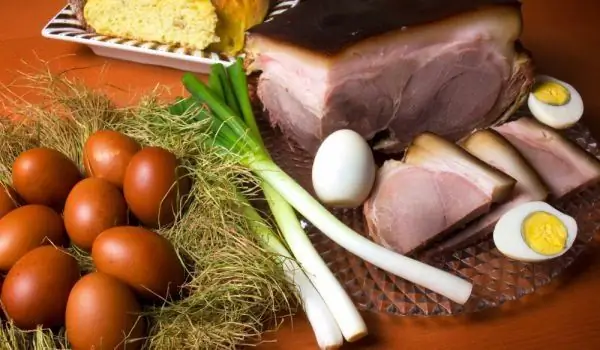2025 Author: Jasmine Walkman | [email protected]. Last modified: 2025-01-23 10:18
Easter is a religious holiday dedicated to the ascension of Christ, but some of the Easter customs, such as the Easter egg, most likely stem from pagan traditions. While for Christians the egg is a symbol of the resurrection of Jesus Christ, which represents his coming out of the tomb, the egg was a symbol even before Christians even began to celebrate the resurrection of Jesus.
The egg as a symbol in history
The ancient Egyptians, Persians, Phoenicians and Hindus believed that the world began with a huge egg, so the egg as a symbol of new life was centuries back in time. Data may vary, but most cultures around the world use it the egg as a symbol of new life and rebirth. Because Easter is in spring, it is also a celebration of this time of year of renewal, when the earth recovers after a long and cold winter. The egg has become synonymous with the arrival of spring.
The egg as a symbol of Easter

From a Christian point of view, the egg represents the resurrection of Jesus. The first book to mention Easter eggs was written 500 years ago. And yet, a North African tribe that became Christian much earlier used to paint Easter eggs. Long and severe winters often meant little food, and a fresh Easter egg was quite a reward.
A notation in the books of Edward I's hosts in England shows the cost of eighteen pence for 450 eggs to be gold and colored for Easter gifts.
Another reason why the eggs became a symbol of Easter, is that in the beginning Christians not only refrained from eating meat, but also eliminated eggs during Lent before Easter. Therefore, Easter was the first opportunity to enjoy eggs and meat after a long abstinence.
It is interesting to note, however, that eggs play almost no role in the Easter celebrations in Mexico, South America and Indian cultures.

The tradition of decorating eggs
The practice of painting eggs dates back to ancient times, when decorated shells were part of the rituals of spring. However, ostrich eggs were used instead of chicken eggs. The first Christians to adopt this tradition were from Mesopotamia, and they painted their eggs red, in memory of the blood of Christ. Methods include using onion skins and placing flowers or leaves on the shells to create patterns. Eastern European countries use wax-resistant batik to create designs by writing with beeswax. Today, food coloring is the most common phenomenon during this holiday.
Decorating small bare tree branches to be an Easter egg has become a popular custom in the United States since the 1990s.
The egg used in the games
We are all familiar with the quintessence of easter eggsbut other countries have different traditionsusing the Easter egg. Some European children go from house to house praying for Easter eggs, very similar to Halloween.
Another game is the Easter roll that the White House holds every year. The laying of eggs is a symbolic incarnation of the rolling of the stone from Christ's tomb. Different countries have their own rules of the game - for example, on the lawn of the White House, children push their eggs with a wooden spoon, while in Germany, children roll their eggs on a track of sticks.
Other Easter symbols

In addition to eggs, Easter is full of images of bunnies, chickens and flowers, because they are symbols of rebirth. The Easter bunny, for example, originated as a symbol of fertility, thanks to the rabbit's rapid breeding habits. It is also part of German Lutheran folklore, where the Easter Bunny judges children's behavior at the beginning of the Easter season.
Recommended:
Blessings And Symbolism Of The Easter Baskets

In many Eastern European countries, it is a tradition to have a basket of food blessed on Holy Saturday or Easter. In Poland, for example the blessings of the Easter baskets is known as święcenie pokarmow wiełkanocnych, a practice dating from the 15th century or earlier, and one that is still maintained by most families in Poland and, to some extent, in other countries.
When Food Is A Holiday And The Holiday Is Easter

Culinary ideas on how to welcome the upcoming holidays in the spring issue of BILLA Culinary magazine. It's spring again and it's holiday time again. The days get longer, the streets more colorful, and the tables tastier. And the stands overflow with freshness, ready to make our lives more appetizing.
Symbolism Of Red Easter Eggs

The custom to paint red eggs on Easter has been adopted by many different countries around the world. There are historical data that prove that since pagan times in ancient Egypt, Gaul, Rome, Persia, China were painted Easter eggs. According to the locals, the egg symbolized the universe and life - the yolk represented the Sun God, the shell - the White Goddess, and the whole egg - the rebirth.
They Check Eggs, Lamb And Easter Cakes En Masse For Easter

Massive thematic inspections in connection with the upcoming major Christian holiday Easter launched the Bulgarian Food Safety Agency. Experts from the Food Control Department will carry out unscheduled inspections at a number of outlets.
Inspections Of Eggs, Easter Cakes And Lamb Begin Before Easter

The joint inspections of the Bulgarian Food Safety Agency and the Consumer Protection Commission start before the Easter holidays. As of today, April 2, intensive inspections in the commercial network and online space of eggs, Easter cakes and lamb, which are traditionally present at the festive table, begin.

